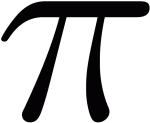 In keeping with the last nerdy post about mathematics, I would like to wish you a happy PI (3.14..) day! In my career in aerospace and also as a pilot and flight instructor, I use the quantity PI (approximately equal to 3.14159265) for all kinds of engineering and navigation applications.
In keeping with the last nerdy post about mathematics, I would like to wish you a happy PI (3.14..) day! In my career in aerospace and also as a pilot and flight instructor, I use the quantity PI (approximately equal to 3.14159265) for all kinds of engineering and navigation applications.
In the excerpt below is the notion that you can approximate the value of PI by throwing needles or frozen hot dogs. Don’t laugh, it works – a group of us a long time ago in a lab at work performed the experiment using tongue depressors. The method uses the laws of probability to approximate PI when you divide the number of throws by the number of times a tossed object crosses one of the reference lines. The lines are set at intervals equal to the length of the objects being thrown.
From SpaceWeather.com
HAPPY PI DAY: March 14th (3.14) is PI day and all around the world mathematicians are celebrating this compelling and mysterious constant of Nature. PI appears in equations describing the orbits of planets, the colors of auroras, the structure of DNA. It’s everywhere.
Humans have been struggling to calculate PI for thousands of years. Divide the circumference of a circle by its diameter; the ratio is PI. Sounds simple, but the devil is in the digits. While the value of PI is finite (a smidgen more than 3), the decimal number is infinitely long:
3.1415926535897932384626433832795
02884197169399375105820974944592307
81640628620899862803482534211706…moreSupercomputers have succeeded in calculating PI to more than 200 billion digits and they’re still crunching. The weirdest way to compute PI: throw needles at a table or frozen hot dogs on the floor. Party time!
